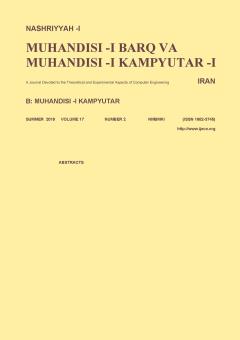User Experience Improvement in Mobile Application Using Information Architecture
Subject Areas : electrical and computer engineeringFATEMEH ZAHRA GHAZIZADEH 1 , sh. Vafadar 2
1 -
2 -
Keywords: User experienceusabilityinformation architecturemobile applicationquantitative evaluation,
Abstract :
User experience is an important issue in the success of commercial mobile applications. Information architecture is a discipline which can be used to design user interface in order to achieve desirable user experience based on user and content analysis. In this research, the impact of information architecture on the software usability is evaluated by a quantitative approach. By selecting a mobile application, logging the users’ interaction automatically, and analyzing the log, usage problems are discovered. Afterward, navigation system is redesigned by using information architecture. Then, the usability of the new version of the application is evaluated. In this experience, 8 metrics are measured in 11 functionalities for each version of the application. Comparing the results show that among 88 measurements, 74 have been improved, 10 have been decreased and 4 have been unchanged. The most improved metrics are time to reach to the functionality, user extra activities and function finding.
[1] م. ع. سلیمانی، ف. ز. قاضیزاده و ش. وفادار، "قابلیت استفاده نرمافزارهاي تلفن همراه: رویکردي کمّی در ارزیابی،" مجموعه مقالات بیست و سومین کنفرانس انجمن کامپیوتر، 6 صص. 72-67، اسفند 1396.
[2] F. Z. Ghazizadeh and S. Vafadar, "A quantitative evaluation of usability in mobile applications: an empirical study," in Proc. Int. Symp. on Computer Science and Software Engineering Conf., CSSE’17, 6 pp., Tehran, Iran, 25-27 Oct. 2017.
[3] B. Shivade and M. Sharma, "Usability analyzer tool : a usability evaluation tool for android based mobile application," International Journal of Emerging Trends & Technology in Computer Science, vol. 3, no. 3, pp. 247-252, May/Jun. 2014.
[4] F. Nayebi, J. Desharnais, and A. Abran, "An expert-based framework for evaluating ios application usability," in Proc. Joint Conf. of the 23rd Int. Workshop on Software Measurement and the 8th Int. Conf. on Software Process and Product Measurement, pp. 147-155, Ankara,Turkey, 23-26 Oct. 2013.
[5] F. Lettner and C. Holzmann, "Usability evaluation framework: automated interface analysis for android applications," in Proc. of the 13th Int. Conf. on Computer Aided Systems Theory, Part II, pp. 560-567, LNCS vol. 6928,pp. 560-567,Springer, Berlin, Heidelberg, 2012.
[6] A. Saleh, R. Bintiisamil, and N. B. Fabil, "Extension of pacmad model for usability evaluation metrics using goal question metrics (Gqm) approach," J. Theor. Appl. Inf. Technol., vol. 79, no. 1, pp. 90-100, Sept. 2015.
[7] J. Heo, D. H. Ham, S. Park, C. Song, and W. C. Yoon, "A framework for evaluating the usability of mobile phones based on multi-level, hierarchical model of usability factors," Interact. Comput., vol. 21, no. 4, pp. 263-275, Aug. 2009.
[8] P. Kortum and M. Sorber, "Measuring the usability of mobile applications for phones and tablets," Int. J. Human-Computer Interact., vol. 31, no. 8, pp. 518-529, Jul. 2015.
[9] A. H. Kronbauer, C. A. S. Santos, and V. Vieira, "Smartphone applications usability evaluation: a hybrid model and its implementation," in: M. Winckler,P. Forbrig, R. Bernhaupt (eds) Human-Centered Software Engineering, HCSE’12. LNCS vol. 623, pp. 146-163, Springer, Berlin, Heidelberg, 2012.
[10] F. Lettner and C. Holzmann, "Automated and unsupervised user interaction logging as basis for usability evaluation of mobile applications," in Proc. of the 10th Int.Conf. on Advances in Mobile Computing & Multimedia, pp. 118-127, Bali, Indonesia, 3-5 Dec. 2012.
[11] W. Kluth, K. H. Krempels, and C. Samsel, "Automated usability testing for mobile applications," in Proc. of the 10th Int. Conf. on Web Information Systems and Technologies, WEBIST’14, vol. 2, pp. 149-156, Barcelona, Spain, 3-3 Apr. 2014.
[12] X. Ma, B. Yan, G. Chen, C. Zhang, K. Huang, and J. Drury, "A toolkit for usability testing of mobile applications," in :J.Y.Zhang, J. Wilkiewicz, A. Nahapetian(eds.) Mobile Computing, Applications, and Services, MobiCASE’11, LNICST vol. 95, pp. 226-245, Springer, Berlin, Heidelberg, 2012.
[13] X. Ma, et al., "Design and implementation of a toolkit for usability testing of mobile apps," Mob. Networks Appl., vol. 18, no. 1, pp. 81-97, Feb. 2013.
[14] R. Duran-Saez, X. Ferre, H. Zhu, and Q. Liu, "Task analysis-based user event logging for mobile applications," in Proc. IEEE 25th Int. Requirements Engineering Conf. Workshops, REW’17, pp. 152-155, Lisbon, Portugal, 4-8 Sept. 2017.
[15] K. Moumane, A. Idri, and A. Abran, "Usability evaluation of mobile applications using ISO 9241 and ISO 25062 standards," Springerplus, vol. 5, Article No. 548, Apr. 2016.
[16] A. H. Kronbauer, D. Machado, and C. A. S. Santos, "Capture and analysis of interaction data for the evaluation of user experience with mobile devices," in A. Marcus (eds.) Design, User Experience, and Usability: Users and Interactions, DUXU15, LNCS vol. 9187, pp. 54-65, Springer, Cham, 2015.
[17] D. Spencer, A Practical Guide to Information Architecture, Five Simple Steps, 2010.
[18] L. Rosenfeld, P. Morville, and J. Arango, Information Architecture: for the Web and Beyond, 4th Ed. 2015.


